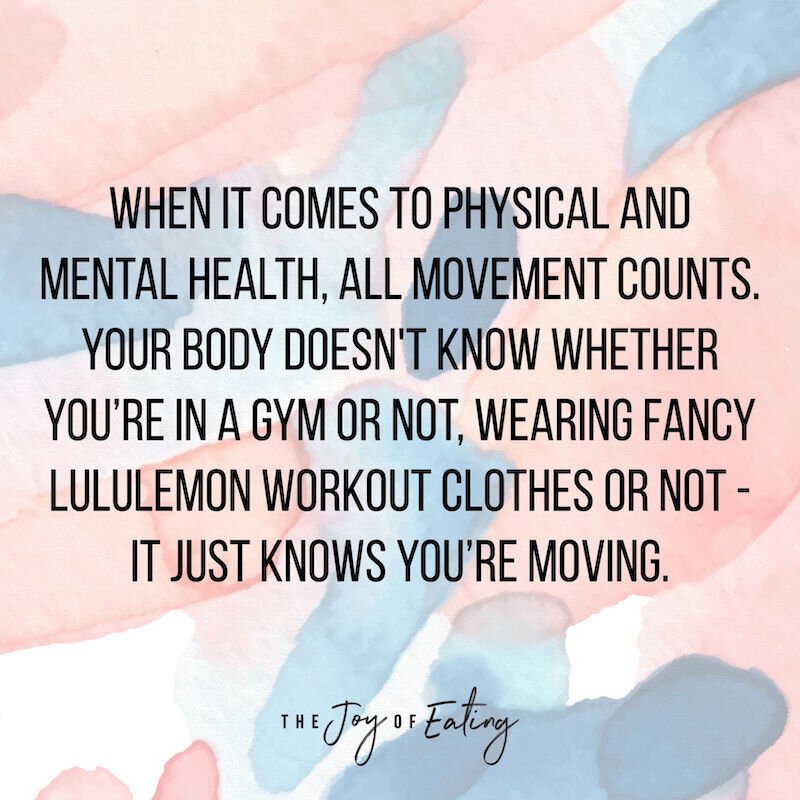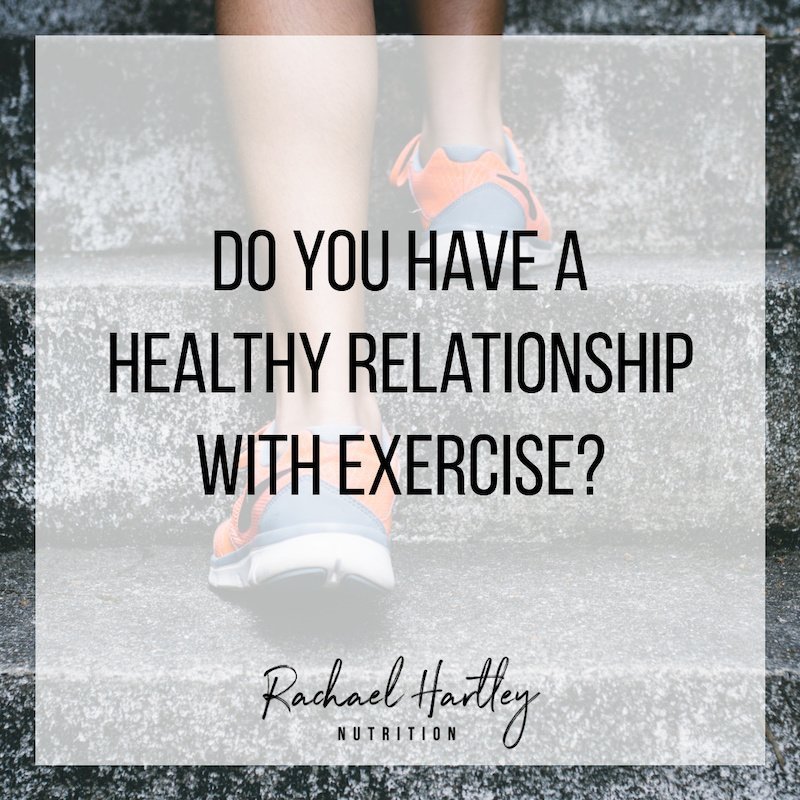Intuitive Eating for Athletes
Because athletes often require a bit more structure than the average human, some people think that intuitive eating for athletes isn’t possible. This blog post busts that myth and shows you how to adapt the principles of intuitive eating for sports nutrition.
If you’re an athlete, or simply an active person, surely you are aware of the fact that food has an impact on athletic performance. Food is our body’s only source of energy, the fuel that allows for every muscle contraction, thought, and deep breath that goes into physical activity. Just like you wouldn’t want to head out on a long road trip with a quarter tank of gas, or put a light and moisture loving plant in a dark corner of your house and forget to water it, your body is not going to do very well in sport if you’re not fueling it with adequate amounts of food.
While pretty much every athlete understands what/how often/how much they eat impacts performance, many (if not most) have a pretty distorted view of what that looks like. Diet/wellness culture proliferates in sports, leading many athletes to feel like they need to eat a very specific and rigid way in order to maximize performance. Not only that, but in many sports – especially female sports – there’s as much of an emphasis on appearance as there is on performance. Athletes are often told to lose weight to boost speed, endurance or agility, asking their body to do more physically while taking in less energy.
It is true that athletes generally benefit from a bit more structure than the average person, but that doesn’t have to mean cutting out foods, counting macros, or restricting calories. For starters, athletes are at elevated risk for developing an eating disorder, especially in aesthetic or weight-class sports like body building, equestrian, crew, gymnastics and figure skating. In these sports, it’s been estimated that 62% of females and 33% of males struggle with disordered eating (no research on trans/non-binary individuals unfortunately). There’s also Relative Energy Deficiency in Sports (RED-S), formerly called Female Athlete Triad. This diagnosis is the result of inadequate energy intake and/or excessive energy expenditure. With RED-S, inadequate energy intake is often completely unintentional rather than the result of attempted weight loss - I often see it with high school and college athletes as a result of simply being busy, trying to balance classes and sports and not having enough time to feed themselves! That doesn’t make it any less serious. RED-S can lead to serious impacts on bone health, hormones, and performance. It also significantly increases the risk of injury. For example, one study found athletes with disordered eating and/or RED-S are twice as likely to sustain an injury during a sports season.
Even if someone doesn’t meet the criteria for an eating disorder or RED-S, underfueling can impact performance. This is especially true when someone restricts carbohydrates, a macronutrient that is simultaneously the body’s main and preferred source of fuel, and the most demonized, commonly restricted food/food group. Undereating in sport can lead to difficulty concentrating/decreased alertness, cramping, fatigue, and decreased power/endurance/strength.
Intuitive Eating for Athletes
Since you’ve clicked on a blog post titled intuitive eating for athletes, I’m going to assume that you have at least a basic understanding of what intuitive eating is. If not, that’s OK! Here’s a helpful primer for you to read, and of course, I’d encourage you to pick up the book Intuitive Eating (4th Edition) to spend more time exploring if it piques your interest.
The tl;dr on intuitive eating is that it is a non-diet approach to eating, meaning the focus is on fueling your body in a way that feels good, physically and mentally, not achieving a number on the scale. Intuitive eating helps you unlearn the unhelpful, inaccurate, and confusing messaging about food, nutrition and weight, and rather than eating according to these external diet rules, you learn to eat according to your body’s internal cues - hunger, fullness, taste preferences, how food makes you feel, etc.
Depending on the sport, there can be many ways nutrition guidance can seemingly fly in the face of intuitive eating principles, even nutrition guidance that is truly focused on performance rather than weight or dieting. Rules or guidance on when to eat before training, how to refuel, how many grams or carbs or protein to consume can contradict your body’s cues. As an athlete, how can you navigate this dilemma?
As I mentioned earlier, while athletes often need a bit more structure with food than the average human being, that does not mean that intuitive eating for athletes is not possible. Not only is intuitive eating for athletics very much possible, IE can also be an incredibly helpful tool for boosting performance. While I am by no means the worlds foremost sports nutrition expert, intuitive eating has been an invaluable tool in my work with athletes and active people in all sorts of different sports, and at different levels.
While athletes often need a bit more structure with food than the average human being, that does not mean that intuitive eating for athletes is not possible.
In the next section, I’ll explore specific principles of intuitive eating, and how each can be adapted for athletes:
Principles of Intuitive Eating for Athletes
Honor Your Hunger & Respect Your Fullness
Intuitive eating teaches you to recognize hunger and fullness cues, and respond accordingly by eating more or less food. When your body is adequately nourished, appetite cues will pretty closely mirror your energy needs, telling you to eat more when your body needs more energy, and eat less when your tank is full.
However, there are two main complications for athletes. One is that athletes often benefit from eating more on certain days, and occasionally less on others, depending on their training schedule. Your body doesn’t know that you have a long run or intense practice scheduled later, so it can’t necessarily respond in advance. Another is that intense physical activity suppresses hunger cues by reducing levels of ghrelin, a hunger hormone, immediately after exercise. While the body typically “makes up” for this by sending more intense hunger cues later on in the day, athletes benefit from being more intentional about refueling after exercise, as muscle tissue is more responsive to nutrition for growth and repair in those first 30-60 minutes after physical activity.
So how do intuitive eating athletes navigate this seeming dilemma? I remind my clients that intuitive eating is all about bringing together brain knowledge and body knowledge. Our body can provide a wealth of information to help guide eating choices, but that doesn’t mean it’s the only source of information. For example, an athlete might experience very low appetite after training, but also know that their body would benefit from refueling with carbs and protein. A way to honor both their body and nutrition needs might be to refuel using a beverage that contains carbs and protein, something that’s not overly filling like chocolate milk or a smoothie. As a side note, I’ve found that eating a snack after exercise typically helps my clients get their appetite back!
Another example might be intentionally choosing more energy-dense foods on days or in seasons where energy needs are higher. Athletes often need a lot more calories than they expect. Rather than eating to physical discomfort, working with a dietitian and choosing foods that are higher in calories for the volume of food they supply, or choosing energy dense supplements, can be helping for meeting ones needs.
Make Peace With Food & Challenge The Food Police
In intuitive eating, there are no good and bad foods. Where many athletes (and people in general!) get tripped up is hearing this and assuming it means nutrition doesn’t matter. That is absolutely not the case. While all foods are morally equal (meaning you are not a better or worse person for eating one food or another), and all foods provide value, that doesn’t mean that all foods are nutritionally equal.
Now, that doesn’t mean that certain foods are better or healthier than others - it simply means that different foods serve different nutritional purposes. For example, most people would consider sugar to be a low nutrition, or “unhealthy” food. It doesn’t provide any vitamins, minerals, or fiber, so how can it be considered healthy? But think about how runners often use energy gels to fuel their runs. Guess what that is? Sugar! You see, while sugar may not provide nutrition through vitamins, minerals, or fiber, it does have a purpose nutritionally!
Different foods serve different purposes. While these salad bowls look lovely and fresh and packed with vitamins, minerals and fiber, they might not be the best choice right before a race, as all the raw fiber might lead to bloating and stomach upset, and because these bowls are a bit light on carbs. It doesn’t mean that they are bad or unhealthy, simply that they might not match the moment for athletes.
For athletes, understanding how different foods can play a beneficial or occasionally detrimental role in their training can be powerful information when foods aren’t labeled as good or bad, but rather thought of as having different purposes. To use a sports analogy, think of different foods as playing different positions on a team. In football, a defensive lineman plays a really important role. But if your team is on the offense and it’s 3rd down, 5 to go, probably wouldn’t be a smart idea to put them on the field! Similarly, while the quarterback is obviously an important member of the team, you wouldn’t ask them to kick a field goal.
Respect Your Body
Intuitive eating teaches us to respect our body and work towards accepting our genetic blueprint. Sports often teaches athletes to manipulate their body, forcing it to try and fit a mold it may or may not have the ability to meet. To some degree, body manipulation may be helpful in sports - for example strengthening leg muscles in soccer or bulking up as a lineman. In certain sports, there may be benefits to having a certain body type. I always think of the Olympics opening ceremony, where there’s lots of body diversity on display when you compare athletes in different sports. It’s not that one body type is better than another - these are all elite athletes, but rather that certain body types are better suited to specific sports. Although there are always exceptions! At 5’ 4”, it’s hard to imagine any way I could have become a professional basketball player, but Muggsy Bogues played 14 seasons in the NBA and was 5’3”!
Most of the time, body expectations have more to do with aesthetics and a pervasive myth that thinner/leaner bodies are faster or more agile. Unfortunately, those pressures are very real, and can have a real impact on one’s participation in a sport. I’m not going to sit here on one side of a computer and tell someone I don’t know who may be trying to go pro or keep an athletics scholarship that’s paying for college that they should ignore the pressure and stop trying to lose weight.
However, if you are reading this and someone who is trying to or considering losing weight for your sport, what I will encourage is being honest and curious with yourself about your weight loss goals, as well as your goals for participating in your sport. Perhaps if there was a magic wand and your body was instantly smaller, it is certainly possible that it might have an effect on your athletic performance. But there isn’t a magic wand, and to the degree weight loss is possible, it means giving certain things up. It may come with risks to your physical and mental health. It may risk harming your athletic performance. At the end of the day, your body might not be able to fit into the mold your sport is asking of you. These are all things worth considering before pursuing weight loss.
Athletes come in different shapes and sizes. One of my favorite plus athletes in Mirna Valero, who makes running ultra-marathons look like a blast! Follow her on IG.
In considering these things, you might decide to express your athleticism in a different way, or revise your goals for participation in a sport. It may be that participation in a sport at a college or professional level isn’t aligning with your values for how you want to care for your body. Or you might decide to keep doing what you’re doing, in your here-and-now body. There are lots of examples of athletes in bigger bodies, like Mirna Valerio (ultra-marathons), Kelly Roberts (runner), Amanda LaCount (dance), Sarah Robles (olympic weightlifting), and Alana Smith (skateboarding) that may be a helpful reminder that thinness does not equal fitness.
The Bottom Line
Being an athlete often requires a degree of sacrifice of time and energy for an activity that you (hopefully!) love. It doesn’t have to mean sacrificing your relationship with food, mistreating your body, and trying to fit your body into a mold that it might be resisting against. Intuitive eating is one tool in the toolbox that athletes can use to fuel their body for sport, and learn how to take care of it in a respectful way. Remember, intuitive eating looks different for every human being, athlete or not. Intuitive eating principles are guidelines, not rules, meaning you’re allowed to adapt them to your unique needs.
If you’re an athlete looking for support integrating intuitive eating into your training plan, we work with clients throughout the US. Read more about our practice philosophy, and reach out to see if we’re a good fit to work together.









